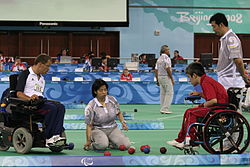Boccia
Boccia is a ball sport played by disabled people including people with cerebral palsy, muscular dystrophy or spinal cord injury. Players use leather or soft plastic covered balls. It was first played at the Paralympic Games in 1984. The sport is for both men and women, who play against each other in competition.[1] It was originally developed to be a sport that could be played by wheelchair users with severe cerebral palsy, was then extended to include other players with severe impairment affecting their movement, and later to the wider community including people with learning disability, milder movement disabilities, or visual impairment.
In the Paralympics there are four categories of players based on their level of disability: BC1, BC2, BC3 and BC4. Players take part in competition one at a time, in twos or in teams of three.[1]
- BC1 - Players in this group throw the ball with the hand or foot. They may play with support from a helper who stands outside of the competitor's playing box. The helper may stabilize or adjust the player's wheelchair and give the ball to the player when requested.[1][2]
- BC2 - players in this group throw the ball with the hand. They are not allowed any help while they are playing.[3][2]
- BC3 - players in this group have very serious movement disability in both hands and feet. They can not grasp or let go of the ball very well, or at all. They may be able to move their arms, but they do not have enough strength, control or range of movement to be able to throw forward a boccia ball onto the court. They use a ramp for the ball to roll onto the court instead of throwing the ball. They compete with a helper who moves the ramp and puts the balls on the ramp for the player; helpers must keep their back to the court and can not talk or look at the game while it is happening.[3][2]
- BC4 - players in this group have serious movement disability in both hands and feet as well as poor control of the torso. They can show enough motor skill to throw the ball onto the court with the hand or foot. Players who use their hand to throw are not allowed any help.[3][2] Players who use their foot or feet to throw the ball have a helper, like BC1 players.
The organisation which controls international boccia is called BISFed - the Boccia International Sports Federation. BISFed write the rules of the international game, control the selection of players for the Paralympic Games, and run competitions for boccia players. The biggest competition is the world championships. The world championships happen every 4 years, two years before and after the Paralympic Games.
Boccia Media
People trying out Boccia in Japan, 2019
References
- ↑ 1.0 1.1 1.2 Joseph P. Winnick (2010). Adapted Physical Education and Sport. Human Kinetics 10%. p. 550. ISBN 978-0-7360-8918-0. Retrieved 25 May 2013.
- ↑ 2.0 2.1 2.2 2.3 Linda Mastandrea; Donna Czubernat (2006). Sports And the Physically Challenged: An Encyclopedia of People, Events, And Organizations. Greenwood Publishing Group, Incorporated. ISBN 978-0-313-32453-6. Retrieved 25 May 2013.
- ↑ 3.0 3.1 3.2 Michael Hutson; Cathy Speed (17 March 2011). Sports Injuries. Oxford University Press. pp. 439–440. ISBN 978-0-19-953390-9. Retrieved 25 May 2013.
